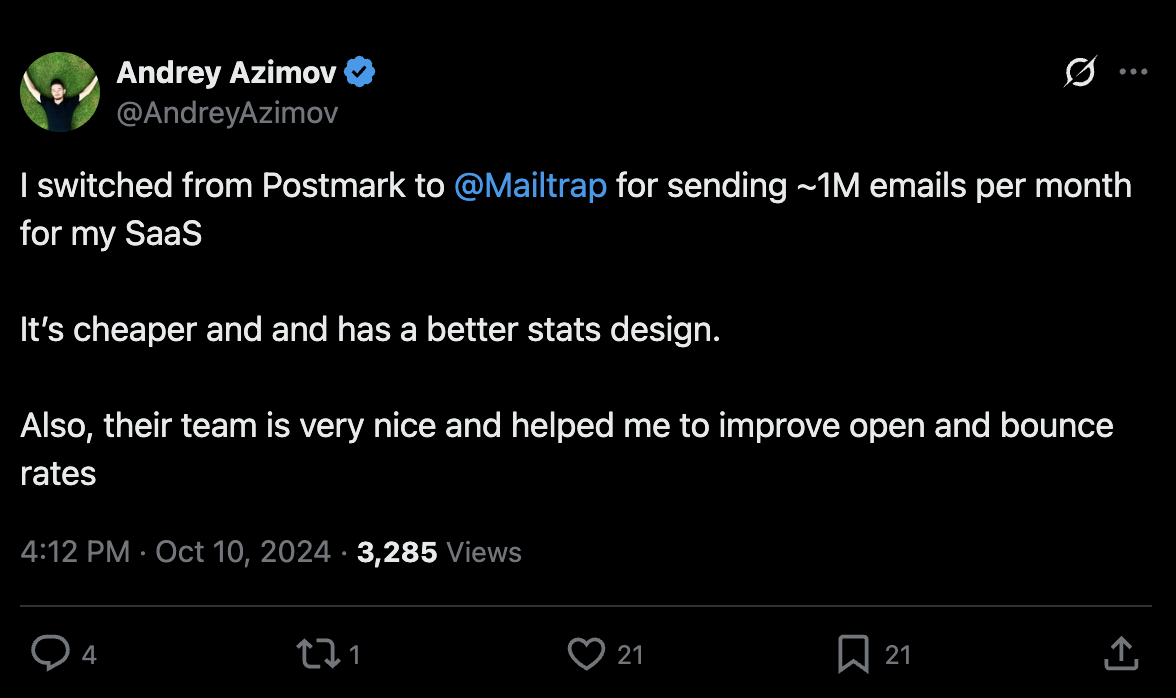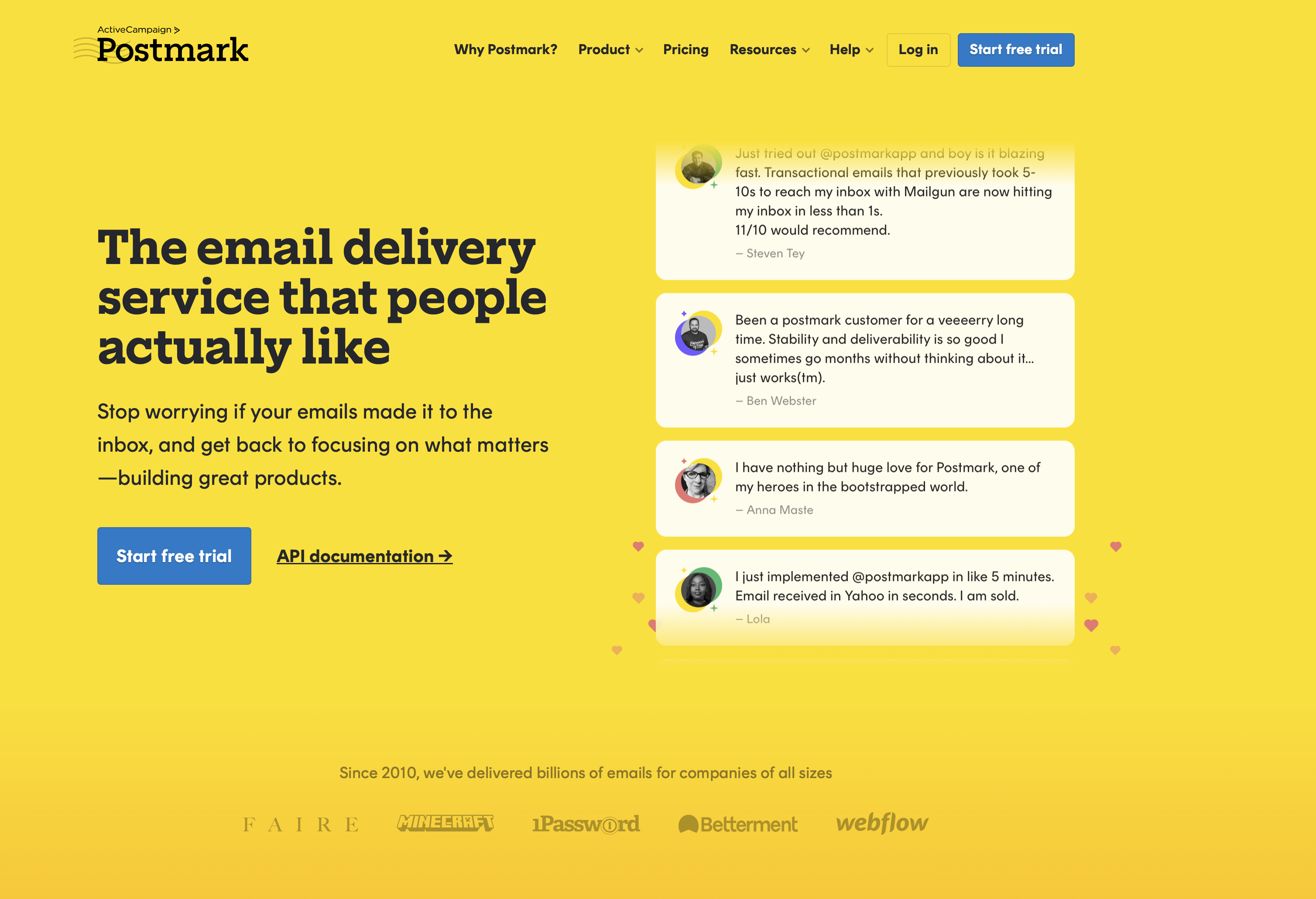Looking for Mailgun alternatives? You’re in the right place!
Yes, I deliberately sound like a used car salesman.
There’s no way to be unbiased, so I didn’t want to miss the opportunity to be charming. However, this article isn’t about making Mailgun look bad and focusing on its shortcomings.
Let’s dig in, and may the best alternative win.
Disclaimer: The article references software catalog ratings, pricing, and features. These were valid at the time of writing, but could be subject to change by the time you’re reading the article.
Mailgun alternatives: a snapshot
- Mailtrap Email Delivery Platform is best for product companies that send transactional, bulk, and marketing emails at scale, focusing on high email deliverability and in-depth analytics.
- SendGrid: For businesses that need a high volume of transactional and marketing emails, developer-friendly APIs, and SMTP.
- Amazon SES: For senior full-stack developers and businesses using other AWS services.
- Mailchimp Transactional Email (formerly Mandrill): For businesses already using Mailchimp’s email marketing service. Note that it’s not a standalone product but an add-on.
- Brevo: For businesses looking for CRM capabilities on top of the email service.
- Postmark: For businesses that need strong transactional email support with an option to send bulk emails via a separate stream.
| Product | Free plan | Pricing |
| Mailtrap | 1000 emails/month | Starts at $15/month for 10,000 emails |
| SendGrid | 100 emails/day | Starts at $15/month for 15,000 emails |
| Amazon SES | 3,000 emails/month for the first 12 months | Pay-as-you-go $0.10 per 1000 emails + additional fees |
| Mailchimp Transactional Email | Free trial of 500 emails (non-renewable) | Starts at $20 per block of emails |
| Brevo | 300 emails/day | Starts at $9 for 5000+ emails |
| Postmark | Free trial only | Starts at $15 |
Mailgun alternatives comparison criteria
The catch is to assess each tool objectively against your business needs. And avoid paying too much, even if your business scales through the roof.
To keep up with the used car salesman charm from the intro, I did all the heavy lifting for you and curated a handful of categories to consider. All distilled into low-tech jargon guidelines.
By the end, you’ll be able to choose whichever service rocks your boat the most. 😀
Email infrastructure
Arguably, this is the most important aspect. I mean, you can have the best automation flows, AI assistants, and whatnot… But if your emails don’t reach inboxes, get stuck undelivered, or the service fails because of too many requests, all the fancy functions are no good.
So, primarily focus on the following:
Deliverability
Before I give you a list of five things to check and our own test results, I need to make a presupposition. I assume your email-sending domain isn’t on any blacklist, and you’re generally a trusted sender.
Otherwise, I suggest you focus on fixing your reputation first.
Now, a service that boasts great deliverability should have:
- Email authentication via DNS records (DKIM, SPF, DMARC).
- Clear monitoring of spam complaints and bounces.
- Access to real-time notifications via webhooks.
- Suppression lists for recipient management and primary list segmentation.
- Dedicated IP address options, ideally with an automatic or guided warmup.
We put our money where our mouth is and did an in-depth deliverability test. As promised, I don’t want to bother you with the technical stuff (you can read the details here); just note that all the tests were done under the same conditions, including:
- Free plan
- Shared IPs
- Same email template (Borrowed from our friends at TitanApps)
- Seed testing for inbox placement
And here are the results:
| SMTP service | Email placement results |
| Mailtrap | Inbox: 78.8% Tabs: 4.8% Spam: 14.4% Missing: 2.0% |
| Amazon SES | Inbox: 77.1% Tabs: 1.9% Spam: 20.0% Missing: 1.0% |
| Mailgun | Inbox: 71.4% Tabs: 3.8% Spam: 23.8% Missing: 1.0% |
| SendGrid | Inbox: 61.0% Tabs: 1.0% Spam: 17.1% Missing: 20.9% |
| Postmark | Inbox: 83.3% Tabs: 1.0% Spam: 14.3% Missing: 0.9% |
Explainer:
Please advise that Mailchimp Transactional Email wasn’t included in the test. Why? First, it’s an add-on to Mailchimp’s marketing service. Secondly, on a free Mailchimp plan, you get only demo access to the service, which could make for an uneven playing field for the rest of the competitors.
Nonetheless, Mailchimp Transactional Email got it into the article since the add-on is still a good choice for people already committed to the Mailchimp ecosystem.
Reliability
Reliability translates to no or very few service interruptions, even on a free plan, and high uptime. By the way, all the alternatives listed in this article provide that, no doubt. But if you’d like some homework, here’s what to look for:
- Multiple server locations and/or data centers.
- Systems to minimize downtime and avoid single points of failure.
- Failover mechanisms and load balancing, like Mailtrap’s ActionMailer balancer, for instance.
- Network redundancy (it’s basically alternative network pathways and connections from various providers).
Scalability
Scalability is the service’s capacity to support your growing demand for emails. At the same time, the growth shouldn’t cost an arm and a leg, and it all needs to be stable without any bottlenecks.
Of course, this all ties with the previously discussed Reliability ⬆️
However, I took things a step further and checked everything related to scaling the services listed in this article. I mean their official docs, status pages, common complaints, you name it.
The verdict is that all the services are highly scalable. The con with some could be the pricing, since high volumes can get quite expensive (Mailchimp, for example). But still, you shouldn’t experience any issue, particularly since I’m assuming you’ll use a dedicated IP.
Pricing
Transactional email services can vary significantly from free plans to paid plans. Plus, I don’t know your budget or demands. So when choosing an alternative to Mailgun, keep things simple and consider.
- Your long-term budget
- What features can you compromise on (I mean the functionalities you don’t need right away)
To the above, always look for a provider that offers a transparent pricing structure. Also, choose a service that allows you to scale easily and quickly when needed in the future, even if it turns out to be a bit pricier from the outset.
Transactional email sending
Transactional emails are typically expected immediately and are often the first communication touchpoint with your brand. These would include welcome emails, password changes, order confirmations, etc. So, the services with powerful transactional email support always tick the right boxes.
But how do you know it’s not only empty promises?
The first thing I do is check the official documents, particularly the ones supporting API integrations. A well-documented service, including a handful of official SDKs, is usually a telltale sign of a good service.
Additionally, I storm the forums and niche websites to check for any red flags or known service disruptions that may affect my workflows. If everything checks out, I’ll move to the next step.
The next step is checking whether the alternative offers me any quality of life features like Mailgun’s MCP server, which make my transactional email sending easier. For example, in the case of MCPs, SendGrid offers one geared towards email marketing, whereas Mailtrap has a cool one that’s also focused on transactional sending.
Marketing email sending
As a marketer, I have a list of things to look for. Of course, this assumes the service offers high deliverability and transactional email support. So, here’s the digest version.
- Segmentation options: From basic suppression lists to advanced campaign segmentation, managing your recipients properly translates to higher engagement and conversions.
- Email design features: A drag-and-drop interface can save a lot of time. But I also like to have access to HTML and the ability to upload existing templates.
- Automation options: Email automation tools are great for reaching out at the right moment if you manage multiple campaigns from various touchpoints. Ideally, you’ll get a service with a visual automation builder and straightforward trigger setup.
- Different sending streams: Having separate streams for bulk/marketing emails and transactional messages protects your deliverability, particularly on a shared IP. In this list, the two services that provide separate streams are Mailtrap and Postmark.
- A/B testing: There’s hardly a better way to test which messaging, copy, and email format best resonates with your audience.
Bonus tip: Most services have some sort of AI assistance. It is most valuable for brainstorming subjects and copy variants for A/B testing and assistance with automation flows. Note that you won’t typically find these features with basic plans, but that’s expected.
Email design
I already covered some bits and pieces, so this section is just a recap of the most critical aspects.
Email template support is now the standard, so all services have it. However, support for HTML email editors and drag-and-drop email builders may make the difference.
Generally, you should look for the software that is easiest for you to use. And even if you drag-and-drop almost exclusively, you should have access to a template’s HTML. This gives you more flexibility and control over the template.
Lastly, check how many templates you can store and manage within the platform.
Customer support and user experience
The best scenario is that a service offers several support channels, such as chat, email, and phone support.
Note that you only get access to email or ticket support with a lower-tier plan. However, this isn’t a deal-breaker as long as the support is responsive. To check that, inspect the service’s social media channels and how they communicate with users, particularly if there are negative comments. This will give you a ballpark idea of how responsive they are.
Also, as mentioned earlier, niche forums and websites can be a treasure trove of info. And that’s not only for customer support, but the general user experience.
However, if I’m perfectly honest, the user experience also depends on your expertise. Namely, some devs swear by Amazon SES, but the service is almost unusable for you if you’re a marketer. So, again, carefully assess your needs and workflows before making a decision.
Best Mailgun alternative: Mailtrap Email Delivery Platform
Mailtrap Email Delivery Platform is designed for product companies with high email sending volumes. The service is great for dev and marketing teams, and it’s comprised of the following:
- Mailtrap RESTful API and SMTP – email-sending for developers with industry-best analytics.
- Mailtrap Email Marketing – create and send impactful email campaigns.
- Email sandbox – to inspect and debug emails in staging, dev, and QA environments before sending them to recipients.
Some core benefits I’d like to highlight are:
- High deliverability by design
- Industry-best analytics
- Human 24/7 support
- SDKs for major programming languages
- Drag and drop email builder
- Email templates editor
- Email template testing mode
- Intuitive contacts management
- AI content assistance and MCP server integration
Mailtrap and Mailgun comparison
Check the table below for a closer comparison of Mailtrap vs. Mailgun features. Alternatively, you can visit our comprehensive guide.
| Feature name | Mailtrap | Mailgun |
|---|---|---|
| Weekly reports | Automatic email alerts | API call |
| Access to deliverability experts | For everyone, for free | On-demand |
| In-depth stats | Separate dashboards | Filter only |
| Email testing | Integrated solution featuring inboxes, team management, and end-to-end email inspection + API for automated testing | Test mode only |
| Dedicated IPs | Yes | Yes |
| Helicopter-view dashboards | Yes | No (color-coded charts) |
If you’re looking to migrate from Mailgun to Mailtrap, we also have a detailed guide.
Pricing
- Free:
- 1,000 emails/month
- Basic:
- $15 for 10,000 emails/month
- $20 for 50,000 emails/month
- $30 for 100,000 emails/month
- Business:
- $85 for 100,000 emails/month
- $200 for 250,000 emails/month
- $300 for 500,000 emails/month
- $450 for 750,000 emails/month
- Enterprise :
- $750 for 1,500,000 emails/month
- $1250 for 2,500,000 emails/month
- $2000 for 5,000,000 emails/month
- Custom
- Price on Request – over 5,000,000 emails/month
Now, I’d like to discuss a typical request for 100K emails per month and do a quick comparison based on that. I’ll do the same for all other alternatives listed here.
On Mailtrap’s Individual plan, you can send up to 100K emails a month for $30. You get one user seat, up to 50K contacts, full access to Email API/SMTP, and email marketing, 2FA, and 24/7 support.
If you bump that up to the Business 100K at $85 per month, you get up to 1000 user seats, SSO, a dedicated IP, and priority support. One of the highlights is that the plan also includes a SaaS safeguard, which is the policy to protect your entire Mailtrap account if you experience issues with one of your sending domains.
Yeah, that’s more expensive than Maiguns $74 Foundation plan, but given the features included, I won’t be cheeky to say you’re getting a bargain.
Customer experience
I could rant about how customers love Mailtrap. But a picture speaks a thousand words, especially if it’s a screenshot of a real user comment. And I encourage you to go out and check what people are saying about Mailtrap.



Pros
- Highly advanced email delivery and testing features
- 24/7 deliverability team support
- GDPR compliance and ISO 27001 certification
- Real-time deliverability alerts
- Detailed performance tracking and analytics
- Responsive customer support and advanced knowledge base
Cons
- Free version more limited than some other services
SendGrid
SendGrid is a good choice for enterprises that need highly scalable email service with many integration options. It’s also good for managing marketing and transactional (user-triggered) campaigns through one platform.
SendGrid and Mailgun comparison
Compared to Mailgun, SendGrid has more comprehensive analytics and, at least for me, more comprehensive documentation, especially for APIs. However, if you need straightforward 2FA, Mailgun is a better option. At the time of writing, SendGrid supported only Authy and SMS, both baked to phone numbers, which could be a pain if you work in a team.
Pricing
You can choose between different tiers segmented into plans for marketers and developers. Both feature a free plan and here’s how much you need to get off the ground.
- For marketers, the pricing starts at $15 per month.
- For developers, the pricing starts at $19.95 per month.
I need to point out that although SendGrid’s pricing seems simple, but it’s quite complex, with various add-ons and upsells that may drive the price up quite a bit.
To give you an idea, the $34.95 Essentials plan allows you to send up to 100K emails monthly. However, you have only one user seat, no SSO, and no dedicated IP. To get those, you either need the $89.95 Pro plan or pay for the additions.
For comparison, Mailgun allows you to send 100K emails a month on their $75 Foundation plan, which includes Multi-user Access (no indications of limitation) and a dedicated IP. However, you don’t get the SSO, it’s gated under Mailgun’s $90 Scale plan, and it’s not available as an add-on.
Pros & cons
Pros
- Various third-party integrations
- Comprehensive technical documentation and API support
- Supports enterprise-level senders
- Detailed analytics (though it has a learning curve)
Cons
- The setup can be complex for novices
- Customer support can be slow with lower-tier customers
- Automations available only on the Advanced plan (marketing product)
Amazon SES
Amazon Simple Email Service (SES) is a cloud-based email-sending service offered by Amazon Web Services (AWS).
It allows businesses and developers to send and receive email using a scalable, reliable, and cost-effective solution. SES enables sending transactional and bulk emails, and it can be accessed through the AWS Management Console, AWS SDKs, or the SMTP and API interfaces.
It is designed to handle high email volumes, making it an ideal option for businesses that regularly send a large number of emails. Some of the core features that the service offers are:
- Customizable email headers and tags
- Automated email sending
- Email bounce and complaint handling
- Email address and content filtering
- Multiple sending domains support
- Dedicated IPs options
Amazon SES and Mailgun comparison
It’s important to note that Amazon SES is more focused on reliability, scalability, and cost-effectiveness. However, it’s more of a bare-bones email provider, which might work out for transactional emails. Still, it is not enough for growing businesses that need to proactively track their sending reputation and measure the impact their emails have.
In this context, Mailgun offers a broader range of features for tracking email performance and controlling email sending data. So, it might still be a solid choice unless you have a reliable dev team to keep up with SES.
Pricing
Note that SES pricing is very nuanced. I’ll cover the basics here, but I strongly suggest you check their official pricing page to determine how much you need to spend.
Amazon SES has a pay-as-you-go model that’s affected by the number of emails you send and receive and the data you transfer. You pay $0.10 for every 1000 inbound and outbound emails at the lowest tier.
As always, I’d like to compare how much it’d cost to send 100K emails. If you do simple maths, 100 * $0.10 = $10 to send 100K emails. It is by far the cheapest service compared to anything else listed here. But I’m afraid it’s not that simple or cheap.
This is the price you pay only for outbound emails. Inbound emails, global endpoints, and Mail Manager features (such as archiving) are all billed separately. Plus, you could be billed additionally for data transfers on EC2.
Accounting for all that, the more accurate estimate would be between $15 and $25. But again, check the official pricing page and account for the developer time spent getting it all up and running.
Pros & cons
Pros:
- Built on the same infrastructure as Amazon.com
- Pay-as-you-go pricing
- Flexible integration with other Amazon Web Services and other systems
- Advanced support options
Cons:
- Limited in terms of analytics and A/B testing features
- Limited in terms of customer support for basic plans
- No email template builder
- Not user-friendly
- Requires advanced technical knowledge to set up and use effectively
Mailchimp Transactional Email
G2: 4.2 Capterra: N/A
As mentioned, this is a Mailchimp transactional add-on, not an independent service.
It allows you to manage email marketing and transactional emails in one place, using the same marketing automation tools and features available in Mailchimp. Some of the key features include:
- Customizable email templates
- A/B testing and split testing
- Email scheduling
- Automated email campaigns
- Real-time tracking and reporting
- Click and open tracking
- Subscription management
- Bounce and unsubscribe handling
- Spam complaint handling
- Dedicated IP address
Mailchimp Transactional Email and Mailgun comparison
The service is a good fit for businesses prioritizing personalized, one-to-one e-commerce and other application-generated emails sent to regular subscribers.
However, Mailgun offers more advanced analytics and delivery tracking for businesses that require more control and data on their email sending.
Pricing
Mailchimp Transactional Email offers block pricing based on the email volume. For example, those who need to send 100K user-triggered emails per month need to pay $80, which is four blocks of emails.
The good news is that the more blocks you purchase, the lower the price per block is. However, you also need to account for Mailchimp’s marketing plans on top of that.
When all is said and done, Mailgun is much cheaper. To send 100K emails monthly, you pay $75, and the dedicated IP is included. The same goes for Multi-User access, 2FA, longer log retention, etc. Plus, it’s a standalone tool, not an add-on.
Pros & cons
Pros:
- Strong deliverability rates
- Personalized, one-to-one e-commerce and other application-generated emails
- Convenient and user-friendly integration with Mailchimp
- Reliable and scalable email sending
Cons:
- Limited in terms of developer-friendly features
- More expensive for high-volume email sending
- Limited in terms of analytics and A/B testing features
Brevo
Brevo (formerly Sendinblue) is a versatile email platform that supports transactional emails, bulk campaigns, and marketing automation. It works with both SMTP and API and offers a solid set of features for teams looking to combine email marketing with CRM and SMS tools in one place.
Some of the key features of Brevo include:
- Email automation workflows
- Drag-and-drop campaign builder
- Transactional email API and SMTP relay
- SMS and WhatsApp messaging
- Built-in CRM and contact segmentation
Brevo and Mailgun comparison
Compared to Mailgun, Brevo leans more toward marketing and all-in-one communication. You don’t get the same depth in developer-oriented tools, but if you need email, SMS, and CRM under one roof, it’s a much better fit.
Pricing
Brevo offers one of the most generous free plans – up to 300 emails per day, forever. Paid plans start at $9/month for 5K emails. It scales with your needs, and while the automation features are gated behind higher tiers, the entry-level value is hard to beat.
But, how about you need to send 100K emails?
In this case, Brevo gives you two options. Here’s a quick breakdown.
- The Starter plan includes marketing, transactional email, and Brevo branding. You can remove the branding for $10.80 per month, and additional fees apply for Dedicated IP and SMS and WhatsApp. Just for the emails you pay $69.00 per month.
- The Business plan allows for one additional marketing user and one landing page. You get up to 500 push notifications, there’s A/B testing, and no Brevo branding. This sets you back $129.00 per month.
Again, Mailgun appears cheaper, and one could think that Brevo has some hidden costs. However, you need to think closely about the use case, and that Brevo supports multiple communication channels and landing pages. So, if you need all that under one hood, the price is well justified.
Pros & cons
Pros:
- All-in-one marketing and transactional platform
- Generous free plan
- Easy-to-use interface
- Includes SMS and WhatsApp messaging
Cons:
- Limited developer documentation compared to pure transactional email tools
- Deliverability isn’t as consistent as Postmark or Mailgun
- Automation features require higher-tier plans
Postmark

Postmark is a transactional and bulk email service that allows businesses to send and receive emails through an API or SMTP server. It’s known for its ease of use, along with a range of reliable features that help understand the performance of your emails.
Some of the key features of Postmark include:
- Real-time email delivery tracking
- Bounce and spam complaint data
- Open-and-click tracking
- Customizable templates
- Various Webhooks
Postmark and Mailgun comparison
Compared to Mailgun, Postmark offers a more user-friendly interface and a more comprehensive range of analytics options. However, Mailgun has a higher sending limit and may be a better option for larger businesses with higher email volume.
Pricing
Besides Mailtrap, Postmark has one of the most transparent pricing options. There aren’t any hidden fees, you can get a free plan of 100 emails a month, and you can send 125K emails for $115 under the Basic plan. I know, it’s not the cheapest option, but in terms of reliability, it’s among the best.
And yes, Postmark is more expensive than Mailgun, but you have to account for up to 5 servers and 15 or more email sending streams. Additionally, you get 45-day email log retention, but note that a dedicated IP is a paid add-on across all plans.
Pros & cons
Pros:
- Focus on deliverability
- Detailed tracking and analytics
- User-friendly interface
- Customizable templates
Cons:
- Not as cost-effective as some other transactional email services
- Slow to deliver emails in comparison to other services
- Limited integrations (to use with most CRM’s and marketing platforms Zapier is required)
Wrapping up
To stress, it’s important to carefully evaluate your business’s needs and choose an email service provider that offers the features and functionality you require.
These six alternatives are among the best email delivery options out there. And you’re now well equipped to make an educated choice without spending a small fortune. So take your pick, and, secretly, I hope it’s going to be Mailtrap.



